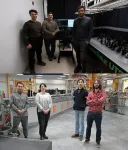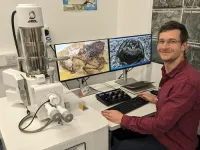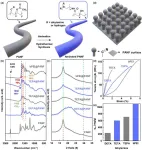(Press-News.org) NEW YORK, April 23, 2024 — Single-photon emitters (SPEs) are akin to microscopic lightbulbs that emit only one photon (a quantum of light) at a time. These tiny structures hold immense importance for the development of quantum technology, particularly in applications such as secure communications and high-resolution imaging. However, many materials that contain SPEs are impractical for use in mass manufacturing due to their high cost and the difficulty of integrating them into complex devices.
In 2015, scientists discovered SPEs within a material called hexagonal boron nitride (hBN). Since then, hBN has gained widespread attention and application across various quantum fields and technologies, including sensors, imaging, cryptography, and computing, thanks to its layered structure and ease of manipulation.
The emergence of SPEs within hBN stems from imperfections in the material’s crystal structure, but the precise mechanisms governing their development and function have remained elusive. Now, a new study published in Nature Materials reveals significant insights into the properties of hBN, offering a solution to discrepancies in previous research on the proposed origins of SPEs within the material.
The study involves a collaborative effort spanning three major institutions: the Advanced Science Research Center at the CUNY Graduate Center (CUNY ASRC); the National Synchrotron Light Source II (NSLS-II) user facility at Brookhaven National Laboratory; and the National Institute for Materials Science. Gabriele Grosso, a professor with the CUNY ASRC’s Photonics Initiative and the CUNY Graduate Center’s Physics program, and Jonathan Pelliciari, a beamline scientist at NSLS-II, led the study.
The collaboration was sparked by a conversation at the annual NSLS-II and Center for Functional Nanomaterials Users’ Meeting when researchers from CUNY ASRC and NSLS-II realized how their unique expertise, skills, and resources could uncover some novel insights, sparking the idea for the hBN experiment. The work brought together physicists with diverse areas of expertise and instrumentation skillsets who rarely collaborate in such a close manner.
Using advanced techniques based on X-ray scattering and optical spectroscopy, the research team uncovered a fundamental energy excitation occurring at 285 millielectron volts. This excitation triggers the generation of harmonic electronic states that give rise to single photons — similar to how musical harmonics produce notes across multiple octaves.
Intriguingly, these harmonics correlate with the energies of SPEs observed across numerous experiments conducted worldwide. The discovery connects previous observations and provides an explanation for the variability observed in earlier findings. Identification of this harmonic energy scale points to a common underlying origin and reconciles the diverse reports on hBN properties over the last decade.
“Everyone was reporting different properties and different energies of the single photons that seemed to contradict each other,” said Grosso. “The beauty of our findings is that with a single energy scale and harmonics, we can organize and connect all of these findings that were thought to be completely disconnected. Using the music analogy, the single photon properties people reported were basically different notes on the same music sheet.”
While the defects in hBN give rise to its distinctive quantum emissions, they also present a significant challenge in research efforts to understand them.
“Defects are one of the most difficult physical phenomena to study, because they are very localized and hard to replicate,” explained Pelliciari. “Think of it this way; if you want to make a perfect circle, you can calculate a way to always replicate it. But if you want to replicate an imperfect circle, that’s much harder.”
The implications of the team’s work extend far beyond hBN. The researchers say the findings are a stepping stone for studying defects in other materials containing SPEs. Understanding quantum emission in hBN holds the potential to drive advancements in quantum information science and technologies, facilitating secure communications and enabling powerful computation that can vastly expand and expedite research efforts.
"These results are exciting because they connect measurements across a wide range of optical excitation energies, from single digits to hundreds of electron volts,” said Enrique Mejia, a Ph.D. student in Grosso lab and lead author of the work conducted at the CUNY ASRC. “We can clearly distinguish between samples with and without SPEs, and we can now explain how the observed harmonics are responsible for a wide range of single photon emitters."
This work was funded by LDRD, FWP DOE on quantum information science, DOE BES, and DOE ECA. The work at CUNY was supported by the National Science Foundation (NSF), the CUNY Graduate Center Physics Program, the CUNY Advanced Science Research Center, and the CUNY Research Foundation.
About the Advanced Science Research Center at the CUNY Graduate Center
The Advanced Science Research Center at the CUNY Graduate Center (CUNY ASRC) is a world-leading center of scientific excellence that elevates STEM inquiry and education at CUNY and beyond. The CUNY ASRC’s research initiatives span five distinctive, but broadly interconnected disciplines: nanoscience, photonics, neuroscience, structural biology, and environmental sciences. The center promotes a collaborative, interdisciplinary research culture where renowned and emerging scientists advance their discoveries using state-of-the-art equipment and cutting-edge core facilities.
About Brookhaven National Laboratory
Brookhaven National Laboratory is supported by the Office of Science of the U.S. Department of Energy. The Office of Science is the single largest supporter of basic research in the physical sciences in the United States and is working to address some of the most pressing challenges of our time. For more information, visit science.energy.gov. Follow @BrookhavenLab on social media. Find us on Instagram, LinkedIn, X, and Facebook.
END
Perfecting the view on a crystal’s imperfection
New research shines light on the properties and promise of hexagonal boron nitride, a material used in electronic and photonics technologies
2024-04-23
ELSE PRESS RELEASES FROM THIS DATE:
Fossil frogs share their skincare secrets
2024-04-23
Palaeontologists at University College Cork (UCC), Ireland, have solved a hundred-year-old mystery of how some fossil frogs preserve their fleshy parts – it’s all down to their skin.
Palaeontologists Daniel Falk and Prof. Maria McNamara, together with scientists from Ireland, Germany and the UK, studied 45-million-year-old fossil frogs from the Geiseltal site in central Germany. Remarkably, the fossils show full body outlines of the soft tissues. The team discovered that the excellent condition of the fossil frogs is due to preservation of ancient skin remnants.
The team studied the fossils with high-precision ...
Existing drugs studied in patients with rare immune diseases
2024-04-23
Existing drugs studied in patients with rare immune diseases
This month the first study within the DRIMID consortium (DRIMID stands for Drug Rediscovery for Rare Immune Mediated Inflammatory Diseases) has started. This study will investigate the efficacy and safety of the drug filgotinib (approved for treatment of rheumatoid arthritis and ulcerative colitis) in three rare immune diseases (Behçet's disease, idiopathic inflammatory myositis, IgG4-related disease). DRIMID aims to investigate whether this drug - despite the absence of formal ...
Loma Linda University study reveals alarming rates of pediatric injuries from mechanical bull riding
2024-04-23
A new study conducted by researchers at Loma Linda University Children’s Health has shed light on the alarming rates of pediatric injuries resulting from mechanical bull riding. The study, titled "Mechanical Bull Injuries in Pediatric Patients: A Call for Safety Regulations," highlights the urgent need for enhanced safety measures and regulations.
The findings were published in the journal Children's Health Care and revealed that mechanical bull riding poses a significant risk to children, with traumatic brain injuries being the most common outcome.
“Mechanical bulls, even when ...
Excessive pregnancy weight gain and substantial postpartum weight retention common in military health care beneficiaries
2024-04-23
ROCKVILLE, Md.— Compared to their civilian counterparts, excessive pregnancy weight gain is more frequent among military health care beneficiaries, in particular active duty personnel, and is associated with costly maternal/neonatal complications. Women in this sample with excessive pregnancy weight gain were also three times more likely to have substantial postpartum weight retention, according to a new study published in the journal Obesity, The Obesity Society’s (TOS) flagship journal.
Substantial weight retention ...
Odor-causing bacteria in armpits targeted using bacteriophage-derived lysin
2024-04-23
Body odor from the armpits comes from bacteria metabolizing sweat produced by the apocrine glands. These bacteria are native to our skin, but the odors produced differ among people. Generally, people use deodorants on their armpits, but perhaps there is a way to get rid of the bacteria.
To find out, a research team led by Osaka Metropolitan University Professor Satoshi Uematsu and Associate Professor Kosuke Fujimoto at the Graduate School of Medicine collected body fluid samples from the armpits of 20 men that were deemed healthy. In advance, a subjective olfactory panel classified ...
Women’s heart disease is underdiagnosed, but new machine learning models can help solve this problem
2024-04-23
When it comes to matters of the heart, cardiovascular disease in women is underdiagnosed compared to men. A popular scoring system used to estimate how likely a person is to develop a cardiovascular disease within the next 10 years is the Framingham Risk Score. It is based on factors including age, sex, cholesterol levels, and blood pressure.
Researchers in the US and the Netherlands have now used a large dataset to build more accurate cardiovascular risk models than the Framingham Risk Score. They also quantified the underdiagnosis of women compared to men. The results were published in Frontiers ...
Extracting high-purity gold from electrical and electronic waste
2024-04-23
Korea relies on imports for most of its metal resources, and in recent years, due to resource depletion and rising raw material prices, 'circular resources' that recycle waste metal resources have emerged. In response, SK hynix has established a mid- to long-term plan to increase the percentage of copper, gold, etc. recovered and reused from waste generated in the semiconductor manufacturing process to more than 30% by 2030, and Samsung Electronics is running a collection program for used mobile phones in cooperation with E-circulation Governance, a non-profit corporation. The global circular economy market is expected ...
Tropical fish are invading Australian ocean water
2024-04-23
A University of Adelaide study of shallow-water fish communities on rocky reefs in south-eastern Australia has found climate change is helping tropical fish species invade temperate Australian waters.
“The fish are travelling into these Australian ecosystems as larvae caught in the Eastern Australian Current, which is strengthening due to the warming climate,” said the University of Adelaide’s Professor Ivan Nagelkerken, Chief Investigator of the study.
“These larvae would not normally survive in the cooler Australian ...
No bull: How creating less-gassy cows could help fight climate change
2024-04-23
A Curtin University study has revealed breeding less-flatulent cows and restoring agricultural land could significantly reduce rising methane emission levels, which play a considerable role in climate change.
The food system, including grazing animals such as cows, generates major sources of methane mainly due to cattle digestion, manure decomposition and land use for grazing.
To look for solutions, researchers from the Curtin University Sustainability Policy Institute analysed 27 academic publications and identified dozens of potential strategies to reduce methane emissions from Australia’s beef and dairy sectors.
Study ...
ECU researchers call for enhanced research into common post-stroke condition
2024-04-23
Lateropulsion, a clinical condition which results in the body leaning to one side, affects about half of all stroke survivors.
Edith Cowan University (ECU) PhD graduate Dr Jessica Nolan said while the problem is common, lateropulsion is still severely under recognised and under assessed around the world.
“A person with lateropulsion uses the limbs on their stronger side, to push themselves over toward their weaker side. Often those with lateropulsion resist correction back towards their stronger ...
LAST 30 PRESS RELEASES:
Bluey’s dad offered professorial chair in archaeology at Griffith University
Beyond small data limitations: Transfer learning-enabled framework for predicting mechanical properties of aluminum matrix composites
Unveiling non-thermal catalytic origin of direct current-promoted catalysis for energy-efficient transformation of greenhouse gases to valuable chemicals
Chronic breathlessness emerging as a hidden strain on hospitals
Paleontologists find first fossil bee nests made inside fossil bones
These fossils were the perfect home for ancient baby bees
Not everyone reads the room the same. A new study examines why.
New research identifies linked energy, immune and vascular changes in ME/CFS
Concurrent frailty + depression likely boost dementia risk in older people
Living in substandard housing linked to kids’ missed schooling and poor grades
Little awareness of medical + psychological complexities of steroid cream withdrawal
Eight in 10 trusts caring for emergency department patients in corridors, finds BMJ investigation
NASA’s Webb telescope finds bizarre atmosphere on a lemon-shaped exoplanet
The gut bacteria that put the brakes on weight gain in mice
Exploring how patients feel about AI transcription
Category ‘6’ tropical cyclone hot spots are growing
Video: Drivers struggle to multitask when using dashboard touch screens, study finds
SLU research shows surge in alcohol-related liver disease driving ‘deaths of despair’
Rising heat reshapes how microbes break down microplastics, new review finds
Roots reveal a hidden carbon pathway in maize plants
Membrane magic: FAMU-FSU researchers repurpose fuel cells membranes for new applications
UN Member States pledge to increase access to diagnosis and inhaled medicines for the 480 million people living with COPD
Combination therapy shows potential to treat pediatric brain cancer ATRT
Study links seabird nesting to shark turf wars in Hawai‘i
Legal sports betting linked to sharp increases in violent crime, study finds
Breakthrough AI from NYUAD speeds up discovery of life-supporting microbes
New Eva Mayr-Stihl Foundation funding initiative boosts research at University of Freiburg on adaptation of forests to global change
The perfect plastic? Plant-based, fully saltwater degradable, zero microplastics
Bias in data may be blocking AI’s potential to combat antibiotic resistance
Article-level metrics would provide more recognition to most researchers than journal-level metrics
[Press-News.org] Perfecting the view on a crystal’s imperfectionNew research shines light on the properties and promise of hexagonal boron nitride, a material used in electronic and photonics technologies







